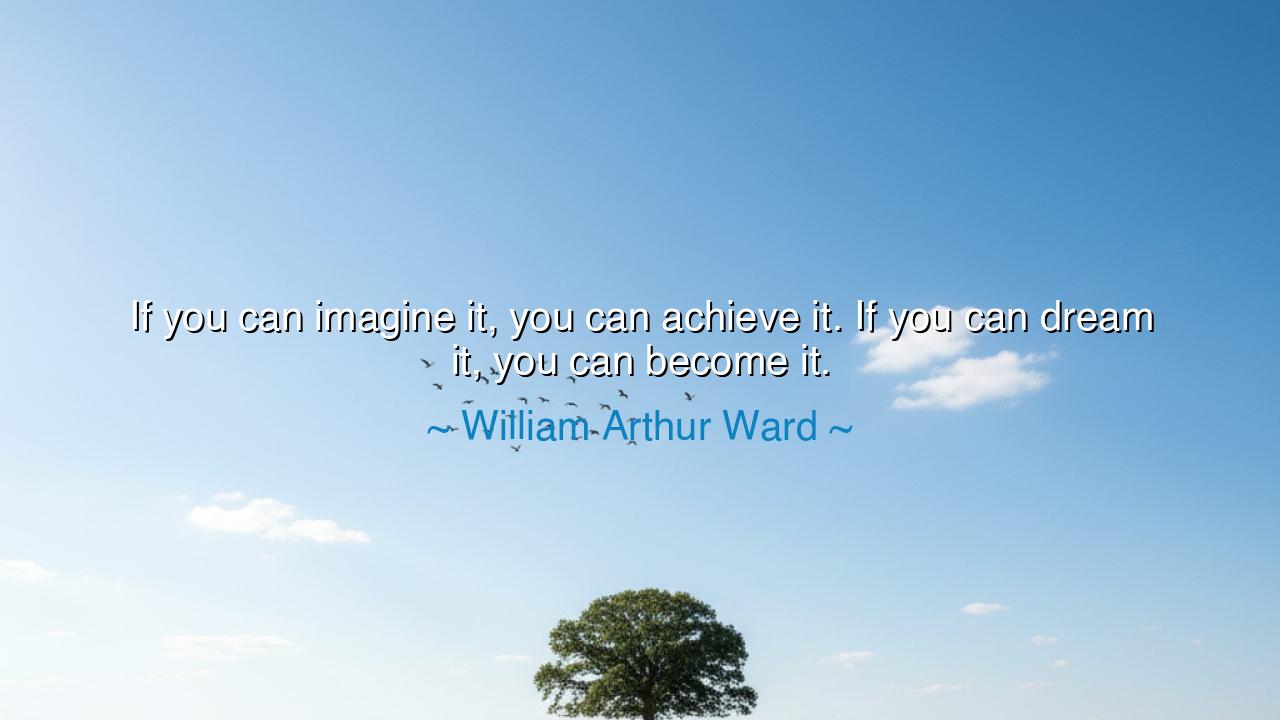
If you can imagine it, you can achieve it. If you can dream it






"If you can imagine it, you can achieve it. If you can dream it, you can become it." — these words by William Arthur Ward echo like the whisper of eternity, a hymn to the boundless power of the human spirit. They speak to the sacred truth that all creation begins first as a vision in the unseen realm of thought. For every monument of stone, every discovery that reshaped the world, every song that stirred the hearts of generations — all were once but dreams, fragile as mist, yet destined to take form through the will of those who dared to believe.
In the dawn of ages, when humankind still looked to the stars and wondered, the wise understood that imagination was not mere fancy — it was the spark of divine creation itself. To imagine is to see beyond the veil of what is, into what could be. It is to commune with possibility, to reach through the fog of the unknown and touch the face of destiny. Thus, when Ward proclaimed that if one could imagine, one could achieve, he was not offering comfort — he was revealing a law of being: that thought precedes reality, and vision summons form.
Consider the story of Leonardo da Vinci, whose sketches of flying machines danced centuries before the first aircraft ever rose to the heavens. He imagined the impossible — wings of wood and silk that could bear man through the air like birds. Though he himself never flew, his visions laid the path for those who would come after — the Wright brothers, who turned dream into achievement. Thus it is shown: imagination plants the seed; courage and persistence water it; time and faith bring it into bloom.
Yet imagination alone is not enough. To dream is divine, but to become that dream is the labor of a soul that refuses surrender. Between the first light of inspiration and the final triumph lies a crucible of trial. Doubt, failure, ridicule — these are the fires that test whether a dream is worthy of being born. But the one who holds steadfast, whose heart remains fixed upon the vision, finds that every obstacle is but a stone on the stairway to destiny. For what we imagine with clarity and pursue with faith, we inevitably embody.
Think, too, of Mahatma Gandhi, a frail man armed with nothing but conviction. In the shadow of empire, he dreamed of a free India — a vision so vast it seemed madness to the powerful. Yet he became that dream through his life of peace, endurance, and moral fire. His body was small, but his imagination was infinite, and through it he shaped the fate of a nation. His life reminds us that one does not need armies to move mountains — only the unwavering belief that one’s dream is sacred.
So, what lesson do we take, children of a restless world? It is this: guard your dreams as treasures of the soul, for they are the maps of your becoming. When you imagine beauty, justice, or greatness, do not dismiss them as idle fancy. They are summons from your higher self, calling you to build what has not yet been built. Fear will whisper that you are too small; the world will laugh that you are too late — yet remember, every miracle begins as the laughter of unbelievers.
Therefore, let your imagination soar unchained. See yourself as the artist of your own fate, the architect of unseen worlds. Dream boldly, not in fleeting wishes but in vivid pictures of what might be. Then, rise each day and take one small step toward it — for each act of faith brings the dream closer to the realm of the living. Imagine, achieve. Dream, become. This is the rhythm of creation, the pulse of life itself. And those who live by it do not merely exist — they become legends, whose dreams continue to shape the world long after they are gone.






AAdministratorAdministrator
Welcome, honored guests. Please leave a comment, we will respond soon